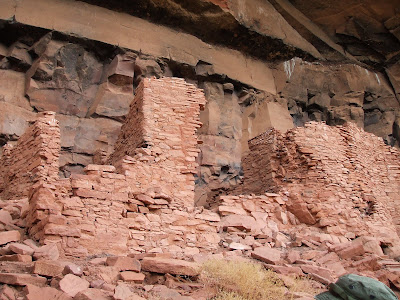We left Durango early the next morning (after our free continental breakfast at the Best Western - that was one of the good things about the place) and headed back westward. Not far down the road we came to the entrance to the Mesa Verde National Park. Mesa Verde is the location of some of the most well-known Native American cliff dwellings in the U.S. True to its name, it is located on top of a high mesa and is entered by a steep, winding road (not unlike the Arches N.P.).
Mesa Verde has a number of sites which were inhabited by ancient native peoples from around 550 A.D. until around 1200 or so. The people are referred to as "Ancestral Puebloans" and are believed to be the ancestors of a number of modern tribes in the southwest U.S. including the Hopi and the Zuni.
The most notable sites are villages built of stone located in natural alcoves in the sides of canyons. The alcoves provided protection from the elements and probably gave them a defensive capability superior to villages built on flat ground. The official Mesa Verde website is here: http://www.nps.gov/meve/index.htm
Anyway, we stopped at the visitor center to determine which site was the most easily accessible given the limited time we had to spend at the park (we had a considerable distance to drive that day). The young woman ranger at the front desk recommended the "Spruce Tree House" as a site that did not require a guided tour. She also assured us that it was a short, 1/2 mile walk into the site. This sounded good to us, so we drove on down the road to Spruce Tree House.
It was a 1/2 mile walk alright: vertically. The site was reached by a series of steep ramps leading down into a canyon. We were hesitant at first, knowing that the walk down was no big deal, but we would, at some point, have to walk back up again. Well, in for a dime, in for a dollar. We hiked down to the site and it was spectacular. The hike back up was, once again, a breathtaking experience (don't forget-we were at about 7,000 feet elevation).

The entrance to the trail

Looking down on Spruce Tree House from about halfway down the trail

Approaching the dwellings

Looks like my old apartment in Jersey City...

This is a "Kiva" - an underground space used for ceremonial purposes. Modern-day Puebloan cultures still use Kivas for ceremonies.

In this view, you can see the cut stone that the buildings are made from.
After our tour, we continued on our journey to Monument Valley - a trip which would take us across the vast Navajo Indian reservation; more properly known as the Navajo Nation.
On the way, we stopped at a kind of touristy, but fun spot called the Four Corners Monument. It is the only place where the boundaries of four states: Utah, Colorado, New Mexico, and Arizona, come together. It is also the boundary between the Navajo nation and the Ute Indian Nation. It's administered by the Navajos as a tribal park, so my old-fart pass didn't get us in free. No matter, we paid the fee and went on in.
Tio Bob casts his mighty shadow over four states

Tia Michelle does likewise.
After posing for the obligatory pictures, we ate some Navajo fry bread from a nearby stand. It's similar to a funnel cake - delicious but probably not very good for you.
Next: The Navajo Nation and Monument Valley







































